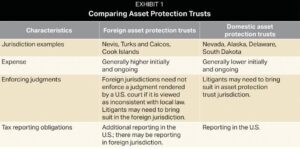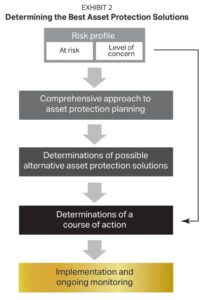KEY TAKEAWAYS
For business owners, high-level executives, physicians and others with significant wealth, asset protection strategies can potentially be key components of an overall cohesive wealth management plan.
The reason is an unfortunate one: People with deep pockets can sometimes be targets of frivolous, unfounded lawsuits that may put their assets, property and future financial security at great risk.
Consider the example of the owners of a small dry cleaner who were sued for $54 million over a disagreement about a pair of pants.* The business owners won, but ask yourself if you’d want to go through an experience even remotely similar.
Here’s a look at ways to potentially safeguard wealth against those who might seek to take it from you unjustly
Asset protection options
Asset protection is similar in many ways to other areas of advanced wealth planning, such as estate planning, business succession planning and charitable planning. It uses an array of legal and risk management techniques, products and structures to insulate your wealth from immoral litigants seeking to separate you from your wealth.
For example, one such legal structure is the conventional trust, which can help shield wealth from lawsuits when used skillfully. In general, one party sets up a trust for the benefit of another party—for example, you might set up and fund a trust that will benefit your minor children. The assets are controlled by the trustee (the person in charge of the trust), and based on your wishes written into the trust document, the trustee will manage the assets and provide for your minor children.
Another option is an asset protection trust. Unlike conventional trusts, asset protection trusts are self-settled—meaning that you potentially retain the beneficial use of the assets that you place in the trust. However, for the assets in the trust to be protected, the trust must be irrevocable—that is, permanent. You cannot just change your mind one day and take out all the assets.
At the same time, you do not control the assets in the trust. Thus, if you are sued, the money and property in your asset protection trust are actually not yours and under your control. Therefore, they can be safe from litigants suing you.
Important: Asset protection trusts are not designed to “hide money” from the world or to keep money blocked against legitimate claims, as some people mistakenly assume. To the contrary, for asset protection trusts to work, they must be out in the open and evident—that way, they can send the message that people pursuing unjust lawsuits are likely to come away with little to nothing.
A look at domestic versus foreign trusts
Broadly, there are two kinds of asset protection trusts: domestic (set up in a selected U.S. jurisdiction) and offshore (set up in a selected non-U.S. jurisdiction). When it comes to domestic asset protection trusts, a number of states have enacted laws that permit some form of self-settled trusts. As of this writing, some of these states are:
- Alaska
- Connecticut
- Delaware
- Hawaii
- Mississippi
- Missouri
- Nevada
- New Hampshire
- Ohio
- Rhode Island
- South Dakota
- Tennessee
- Utah
- Virginia
- West Virginia
- Wyoming
As for offshore (or foreign) asset protection trusts, there are various non-U.S. jurisdictions that have enacted laws supporting self-settled trusts. Some examples as of this writing include Nevis, the Turks and Caicos, and the Cook Islands. Generally, it’s less expensive to set up and maintain a domestic asset protection trust. That said, foreign asset protection trusts may be more effective than are domestic trusts at dissuading unfounded, frivolous lawsuits. One reason is that the case law surrounding and governing foreign trusts in many cases is more certain and better established than it is in the U.S.—potentially giving the foreign trusts stronger protection.
 Also, with foreign asset protection trusts, the laws of that jurisdiction—not U.S. laws—are in effect. So, for example, some foreign jurisdictions may be disinclined to enforce U.S.-based judgments against the wealth held in the trusts formed in their jurisdictions. In some jurisdictions, the creditor will have to have a new trial, and the statute of limitations for the underlying claim may have run out already.
Also, with foreign asset protection trusts, the laws of that jurisdiction—not U.S. laws—are in effect. So, for example, some foreign jurisdictions may be disinclined to enforce U.S.-based judgments against the wealth held in the trusts formed in their jurisdictions. In some jurisdictions, the creditor will have to have a new trial, and the statute of limitations for the underlying claim may have run out already.
Additionally, many foreign jurisdictions allow for only actual damages—there are no payments for “emotional distress” or other punitive damages that are commonly seen in the U.S.
It’s important to note that while asset protection trusts (whether domestic or foreign) can be useful, they might not be the best first line of defense against frivolous and unfounded lawsuits.
Instead, a more logical starting point is to develop a deep understanding of your own risk profile—which is a function of the actual risks you are facing along with how concerned you are about these risks. Armed with that information, you can begin to implement a systematic process (see Exhibit 2).
Usually, we find it’s best to take a comprehensive approach to asset protection planning based on your risk profile. There are various possible ways to insulate your wealth—including but not limited to asset protection trusts. Ultimately, possible solutions should be identified and a course of action should be chosen. Again, your risk profile should be a major factor in deciding on the most appropriate asset protection solution or solutions for your situation.
If you determine that an asset protection trust makes sense, then it’s time to consider decisions about whether to go with a domestic or a foreign jurisdiction—and then which specific state (or offshore location) potentially may give you the best outcomes you’re looking for.
Last, there is implementation and ongoing monitoring. Implementation tends to be very straightforward (especially among high-quality financial advisors and experts). Ongoing monitoring is critical to determine whether any changes—to your situation, in laws impacting the solution or to the general environment—might adversely impact your asset protection strategies’ effectiveness.
The bottom line is that the best approach will depend on the specifics of your situation and how they might change over time. The good news: You probably have a number of options that potentially can help protect and shield your assets from being unjustly taken from you.








